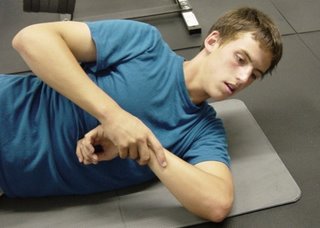Let’s see…there’s tennis elbow, golfer’s elbow, gamekeeper’s thumb, house-maid’s knee, turf toe, boxer’s fracture…well you get the point.
I’m campaigning to add a new diagnosis…Bodybuilder’s shoulder.
Here’s why.
Given enough time, a large portion of bodybuilders, powerlifters, and general strength training enthusiasts experience shoulder pain.
A study from the Journal of Strength and Conditioning Research (J Strength Cond Res. 2002 Aug;16(3):367-72) outlines the findings that the bodybuilders tested showed significant deficits in shoulder internal rotation and relative weakness in the lower trapezius muscles.
The lack of shoulder internal rotation is much like the similar findings in throwing athlete’s who experience shoulder impingement.
A quick test to see if you’re at risk for Bodybuilder’s Shoulder is to assess your full shoulder rotation. A normal test would be considered to have 180 degrees of combined external and internal rotation.
Here’s the test…
Put your arm in a “high five” position with the upper arm parallel to the floor and 90 degrees at the elbow,, and the hand facing forward. This is external rotation. Keeping the upper arm in the same position, rotate the hand downward so it now faces backward. This is internal rotation.
The total arc (without moving your shoulder blade!!) should be 180 degrees.
Now if you can rotate further into external rotation than the normal 90 degrees (thrower’s tend to have increased external rotation), the increase in external rotation should equal the loss of internal rotation. In other words, as long as the total range of motion is 180 degrees you pass the test.
If you lack 180 degrees of full rotation with a loss of internal rotation, you’re more at risk for shoulder injury…Even if you don’t have pain right now.
The fix is to start stretching your posterior shoulder muscles and the posterior shoulder capsule until you regain the lost internal rotation.
Try this stretch…
Gently push your hand toward the floor until a comfortable stretch is felt in the back of the shoulder. Hold the stretch for about 30 seconds and repeat 2-3 times. Be sure to avoid shrugging the shoulder. Repeat this stretch frequently throughout the day. Think frequency over intensity to start as it’s easy to strain the shoulder in this position.
Later
P.S. If you’re serious about your training and want to raise your upper body training performance while preventing injuries check out Inside-Out.
